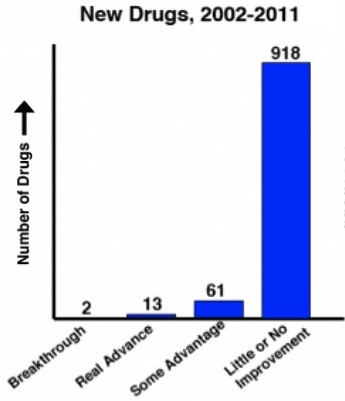Big Pharma Drugs
Big Pharma Drugs

(continued from Big Pharma Corruption)
What is the outcome of Big Pharma's corruption?
Big Pharma's corruption produces dangerous drugs, worthless drugs, exorbitant drug prices and other harmful consequences. Here are eight of them.
1. Dangerous drugs
When a new drug made by Big Pharma is found to be dangerous, even deadly, its maker estimates the probability of the deaths and injuries being linked to the drug, the probability of being sued, the probability of losing in court, and the cumulative potential damages to be paid. If that amount is less than the profit to be made by selling the drug, it is taken through the approval process and marketed. This is why newly approved drugs have a 1 in 5 chance of causing serious adverse reactions. A systematic review of hospital charts found that drugs properly administered as prescribed cause about 1.9 million hospitalization, cause serious adverse reactions in 840,000 hospitalized patients, and kill about 128,000 people annually (source). Prescription drugs rank alongside stroke as the fourth or fifth leading cause of death in USA.
 2. Worthless drugs
2. Worthless drugs
Despite the advertised hype by Big Pharma, the vast majority of its newly approved drugs are later found to offer no benefit over existing drugs or no benefit at all. One study found that of the 994 new drugs approved from 2002 to 2011 (image), 918 (92%) were found to offer little or no advantage over existing drugs (source).
3. Lack of drugs that cure
Because a cured person is a lost customer, Big Pharma avoids developing drugs that can cure diseases, and instead focuses on drugs that keep sick people sick but alive so that they can remain paying customers.
Part 1 of 2:
Part 2 of 2:
4. Falsely advertised drugs
Big Pharma pressures Congress to limit the budget of the FDA (see below), whose officials increasingly prefer to not use their limited resources to police and offend their future employers. For example, from 1997 to 2016, the number of consumer and professional drug promotional materials that the drug makers submitted for FDA review increased 283% from 34,182 to 97,252, while the number of violation letters the FDA issued for misleading drug marketing fell 93% from 156 to just 11 (source), leading to rampant false advertisements.
5. Exorbitant drug prices
USA has by far the highest prescription drug prices in the world. In 2019, the per capita spending on prescription drugs was $1,229 in USA, compared to $430 in The Netherlands, $473 in Norway, and $665 in Austria (source) - all advanced economies with high cost of living. Prescription drug prices are so high in USA that many poor Americans forego groceries to buy them or forego drugs and get sicker. For example, in USA, the richest country in the world, the proportion of diabetics who ration their insulin is 26%, the highest in the world (source).
Big Pharma claims that its high drug prices are needed to fund its research and development of new drugs to the tune of $2-3 billion per drug, but this claim is false for three reasons. First, 80% of the research and development for new drugs actually take place in tax payer-funded government labs and public universities; Big Pharma simply swoops in and takes the drugs that show potential through the clinical trials and FDA approval process. Second, the cost to develop a new drug actually averages only about $100-200 million (source). Third, its claims don't explain why it charges so much less for the same drug in countries other than USA. For example, a vial of insulin that sells for $6 in Austria sells for up to $300 in USA (source). The bulk of the Big Pharma's costs in reality are cash payouts to politicians, drug trial investigators, medical journal editors, FDA advisory panel members, government regulators, the media, doctors, hospitals, competitors, and pharmacy benefit managers to create and protect monopolies around dubious drugs (see Big Pharma Corruption).
6. Misallocated government spending
In 2019, the U.S. federal government spent $1.41 trillion on healthcare, including $234 billion of heath care-related tax credits (source). The gap in per capita prescription drug spending between USA and even Austria is 46% (see above). If the U.S. federal government were to spend that much less on healthcare, an extra $635 billion would be available for building roads and bridges, shoring up Social Security, paying down our national debt, etc.
7. Neutered FDA
The richest country in the world annually spends a paltry $1.95 billion (33% of $5.9 billion below) to safeguard the drugs its citizens ingest, and 65% of that comes from fees that the drug makers pay to have their new drugs approved (source). The FDA remains so underfunded and short-staffed that instead of monitoring and policing Big Pharma, it has become dependent on it.

8. Inability to sue vaccine makers
Big Pharma has managed to get the Congress to pass a law that prohibits U.S. citizen from suing the vaccine makers when their vaccine causes death or injury:
"No vaccine manufacturer shall be liable in a civil action for damages arising from a vaccine-related injury or death associated with the administration of a vaccine after October 1, 1988, if the injury or death resulted from side effects that were unavoidable even though the vaccine was properly prepared and was accompanied by proper directions and warnings" (42 U.S. Code § 300aa–22).